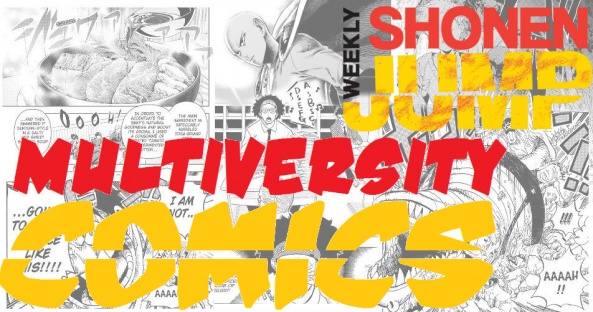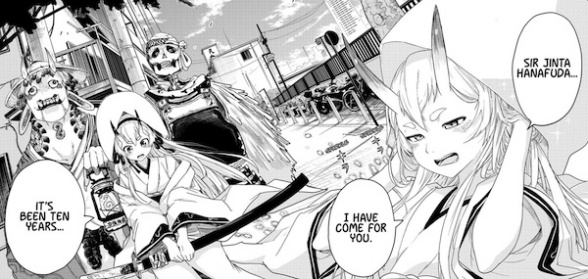
Welcome to This Week in Shonen Jump, our weekly check in on Viz’s various Shonen Jump series. Viz has recently changed their release format, but our format will mostly remain the same. We will still review the newest chapters of one title a week, now with even more options at our disposal. The big change for our readers is that, even without a Shonen Jump subscription, you can read these most recent chapters for free at Viz.com or using their app.
This week, Rowan checks in with “Tokyo Demon Bride Story.” If you have thoughts on this or any other current Shonen Jump titles, please let us know in the comments!

Tokyo Demon Bride Story Chapter 1
Written and Illustrated by Tadaichi Nakama
Reviewed by Rowan Grover
“Tokyo Demon Bride Story” is one of those names I feel my eyes would glaze over if this weren’t a series debut. The name evokes the excess and fanservice that anime is infamous for, and the cover and promo images don’t do a lot to help that. However, Nakama’s debut Shonen ongoing is filled with more heart and had me chuckling a little more than I expected. The setup is one that hits pretty close to home for those who ever visited a holiday home away from the city in their youth. It’s revealed that our protagonist Jinta, on one of the said trips, rescued and proposed to a wayward demon princess, Manaka. Nakama renders the Japanese countryside well in these flashbacks, giving a nostalgic and cozy sense to the way things are framed. This isn’t a sprawling field, it’s more of a tucked-away corner, with lots of tree roots and detailing to make it feel like a secret childhood nook that only you know about.
Getting to the meat of the story, however, we skip to ten years later when Jinta is living with his two sisters in the city. Manaka arrives on his doorstep to make good on the marriage proposal that was made as kids, and hijinks ensue from there. Let’s unpack the good first of all. Jinta falls into a trope of modern manga stereotype that I’ve found pop up a lot lately: the barely-adult man who balances work and school to support and house his siblings. It’s an archetype that I feel might be worth looking into on its own, but for now, it works as an express method of making our protagonist feel sympathetic, kind-hearted, and human. Jinta means well but he’s become disillusioned by having to support a family at the much-too-early age of seventeen and acts a little disgruntled. This means Nakama can insert the demon princess Manaka as the perfect offset to his character.
Manaka represents the wayward, wanderlust youth that Jinta had to forgo. She’s hyper-passionate and feels everything to the utmost, which is sharpened to comedic effect by having her demonic cronies hang around constantly and having her own superhuman strength on display. Nakama gets to really flex her art with these supernatural elements. Her rendition of Manaka is of a cute teenage-appearing girl with a kimono and long devil horns, but these demonic effects often crackle around her like barely-contained energy. Her escorts at Jinta’s door near the beginning of the comic are these bestial/skeletal hybrids adorned in bits and pieces of feudal Japanese clothing. Other times Manaka will summon little demon aftereffects when she’s emotional, like giant faces appearing from the ceiling or floating, flaming skeletal heads. It’s a great way to breathe a unique art style into a series that would otherwise feel like a pretty generic slice-of-life manga.
By the end of the comic, a demon attacks Jinta and Manaka, in which both of them serve a key role in each other’s survival. From this moment, we get super-dynamic character development that sets these characters on a path to explore as the series continues. Jinta accepts that Manaka won’t be going away any time soon and starts to embrace her role in a way that feels like him re-connecting with his childhood self, encouraged by his sisters who are thoroughly enjoying having these crazy demons around the house. Manaka accepts that Jinta isn’t the same person he was ten years ago, which is Nakama showing her becoming willing to accept that people change.
The art is just as exciting and fluid in this battle scene too. Nakama has the demon opponent bound around the battlefield like a frog, shifting the perspective dramatically as the character moves. The overall panel structure is played pretty safely in these moments, but the camera and lens style continue to ripple and expand as the fight gets more heated. When the frog demon Kawanpa uses a special magical move, the camera bubbles like a fish eye around the “hand water ball” being charged up. The finale of the fight really takes the cake, however, as Manaka summons a pillar of energy with a sword slice in a tilted half-splash page that uses speed lines to convey a conical slicing movement. It’s Shonen battle manga honed to a fine point, and Nakama uses camera angling to great effect here.
Final Score: 9.0 – “Tokyo Demon Bride Story” was an unexpectedly fun and well-realized debut, with characters that are already established with meaningful personalities and motivations. I hope the momentum is sustained in the coming weeks.






